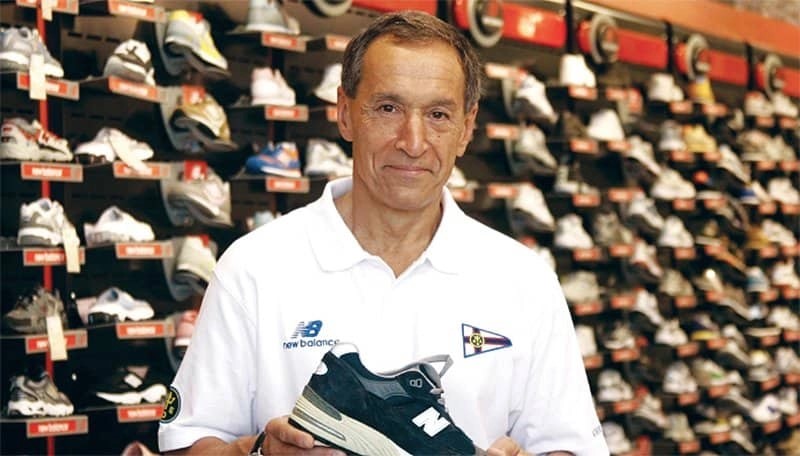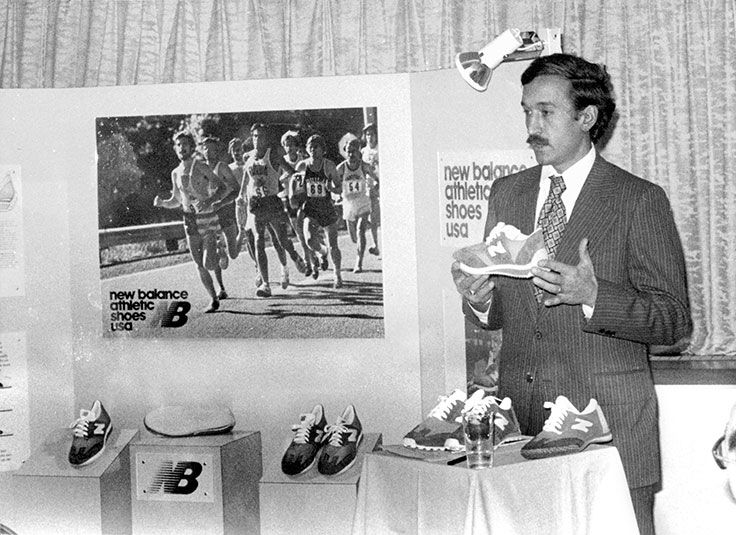By Colin McCandless
Contributing Writer
BOSTON – New Balance gear is now a $5 billion global shoe, clothing and sports equipment brand with more than 8,000 employees worldwide. Its apparel is endorsed by some of the biggest names in professional tennis including top 3-ranked American and newly-minted US Open champion Coco Gauff and top 15-ranked American Tommy Paul.

Gauff was wearing her signature New Balance CG1 shoe while winning her first major singles title in September. Major League Baseball two-way superstar Shohei Ohtani and NBA champions and all-stars Kawhi Leonard and Jamal Murray have also inked deals to represent New Balance. What used to be regarded as a fashion-challenged sneaker for dads is setting trends in the 2020s as the stylish, comfortable shoe everybody wants.
But New Balance, which was founded in Massachusetts, launched as a one-man operation that grew quite gradually over the course of more than a century, changing hands a couple of times before eventually blowing up into the thriving multinational corporation it is today. According to Forbes, as of 2023, New Balance sells footwear and apparel in more than 120 countries worldwide. Yet for decades, its reach barely extended beyond the Boston area and shoes remained the “sole” focus of the enterprise.
Early 20th century origin
New Balance had its humble origins in Boston, where English immigrant William J. Riley established New Balance Arch Support Company in 1906. His idea was to develop arch supports and orthopedic footwear that as the company name implies, would provide people with both comfort and “new balance.” As the story goes, he drew innovation from observing his backyard chickens perfectly balance on three claws, inspiring him to invent a flexible arch support with three support points.
In 1927, Riley hired a traveling salesman named Arthur Hall to pitch his New Balance Arch Support product, as it was not yet available in retail stores. The personalized approach helped set it apart from other competitors and slowly build its reputation one shoe at a time. Hall became a partner in the company in 1936 as they began targeting their product toward people who work on their feet all day such as retail workers and first responders.

The year 1938 marked a watershed moment for New Balance, when they created their first running shoe, which Riley designed for a local running club called the Boston Brown Bag Harriers. In 1941, New Balance transitioned into manufacturing shoes for team sports including baseball, boxing and a sport with which they are now closely associated—tennis. Despite the leap into sports, they remained a low-volume producer in which every shoe was assembled in-house by a small team of workers.
A change of ownership came in 1953 when Arthur Hall sold the company to his daughter Eleanor and her husband Paul Kidd. They kept the initial focus on orthopedic footwear and general shoes, then ultimately switched to making sports footwear geared specifically toward athletes.
Growth and expansion
Entrepreneur Jim Davis, the Brookline-born son of Greek immigrants, purchased New Balance in 1972, which then had a staff of only six full-time employees averaging an output of 30 pairs of shoes per day. At the time, the business had less than $1 million in annual sales. Davis, the current chairman of New Balance, would go on to grow and expand the business exponentially. He is currently ranked in the top 150 richest people in the United States with an estimated net work of $6.5 billion.
In 1976, New Balance released the 320 running shoe, the first to be adorned with the ‘N’ logo, a successful endeavor that made it the number one running shoe on the market by Runner’s World magazine. Another milestone moment came in 1978 with the arrival of the business’ first clothing line, featuring Gore-Tex suits, nylon and mesh singlets and tricot shorts and tops.
Various shoe models and styles were introduced throughout the 1980s and ‘90s, with several in particular receiving popular acclaim, such as the 990 (the first sneaker to retail for $100) and the 1500, the latter of which was worn by President Bill Clinton during his runs. The 574 sneaker, which debuted in 1988, has now become an iconic lifestyle shoe celebrated for its comfort, support and walkability.
In 1998, New Balance’s reissue of the 576 model was featured on the cover of the women’s fashion and lifestyle magazine Elle, garnering the attention of the fashion world. More positive publicity came when Apple CEO Steve Jobs was spotted regularly wearing New Balance’s 991 model in the early 2000s. By 2000, the company had reached $1 billion in sales.
New Balance resisted endorsements until 2009, when they started enlisting professional baseball and basketball players to promote the brand image. In 2012, the company launched a shoe specifically designed for President Barack Obama, the 990 ‘Made in the USA’ sneaker. From 2014-15, New Balance branched out into professional tennis endorsements for the first time, tapping Canadian men’s player Milos Raonic and later British women’s player Heather Watson as brand ambassadors. In 2018, New Balance, further bolstered its status in popular culture, collaborating with Marvel to create two special edition shoes for the “Black Panther” movie.
Fashion collaborations
Despite its skyrocketing growth and aspirations of doubling its current revenue to become a $10 billion company, New Balance’s headquarters has remained in Boston for the entirety of its 117-year existence. Riley may never have envisioned that New Balance would have transformed into a global corporate player, but his original emphasis on comfort and support were never compromised as the business made tremendous strides.
So, what is the source of New Balance’s exploding popularity and how did they evolve from a purely functional dad shoe to appeal to a hip and trendy crowd? Recent successful collaborations with New York fashion and lifestyle brand Aime Leon Dore and Chicago designer Joe Freshgoods have helped boost its image among a younger generation and expose them to a wider, more diverse audience outside of running and casual footwear for dads. Further expanding its youth reach, it has also launched a skateboarding shoe brand.
It’s also a versatile shoe that you can pair with a variety of outfits and styles. They’re worn by those who have to work on their feet all day, and for leisure purposes such as walking, playing tennis or just hanging out. New Balance itself attributes their business success to a combination of factors including innovation, an entrepreneurial spirit, quality craftsmanship and a little bit of risk taking. Whatever the reason, this Boston-founded company has come a long way and still has lofty ambitions for the future.
RELATED CONTENT:
Iconic Converse Chuck Taylor All Stars sneaker got its start in Malden












